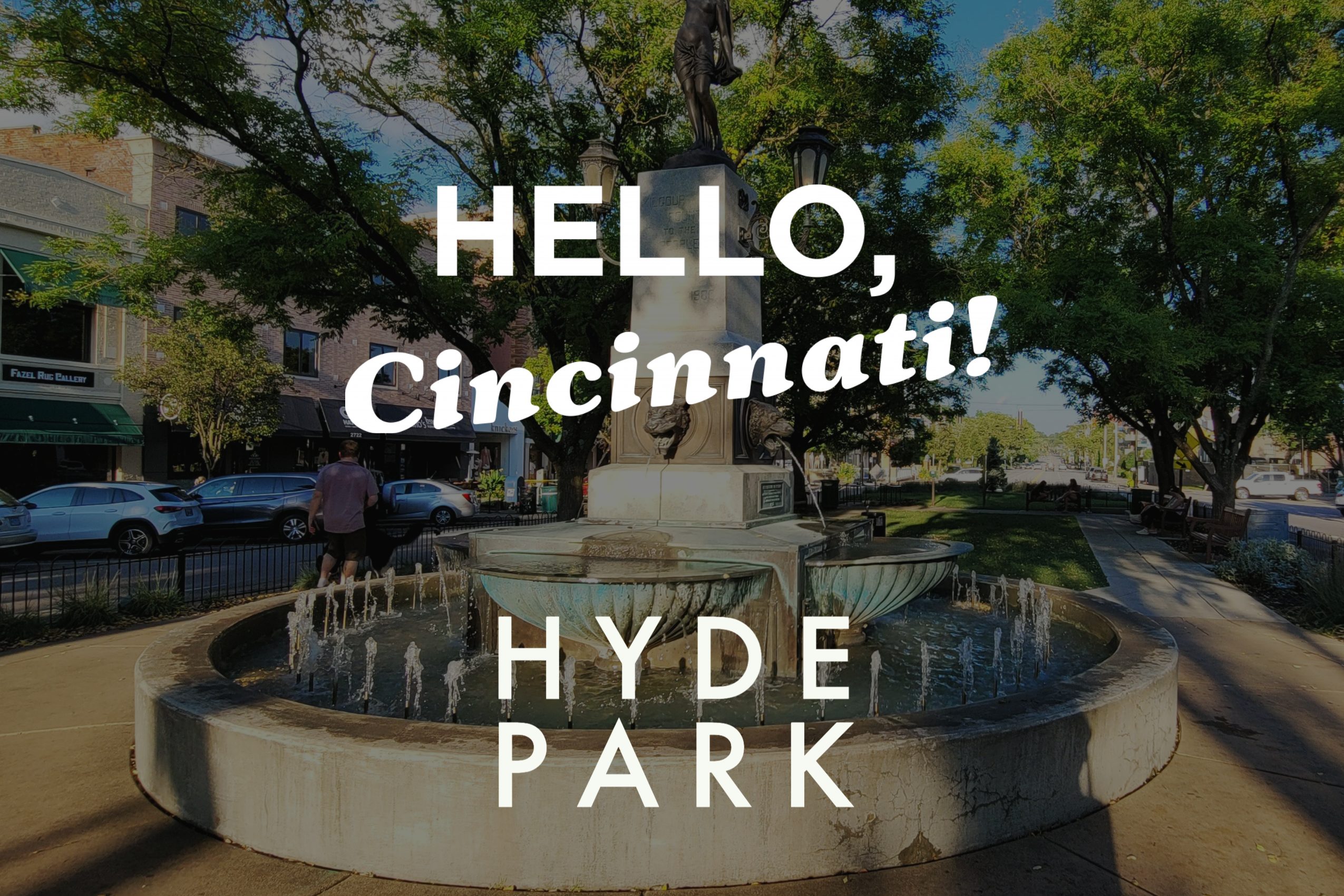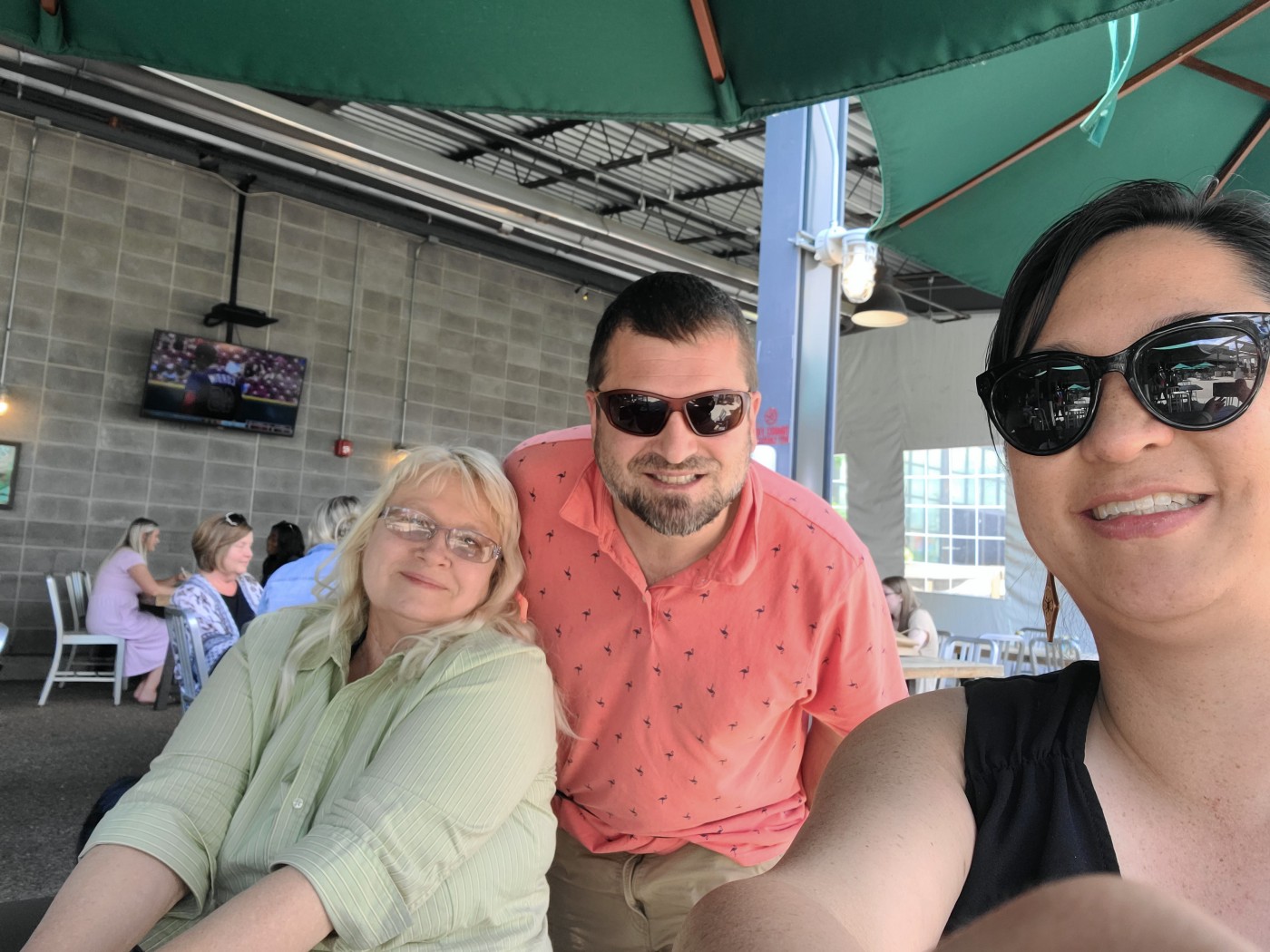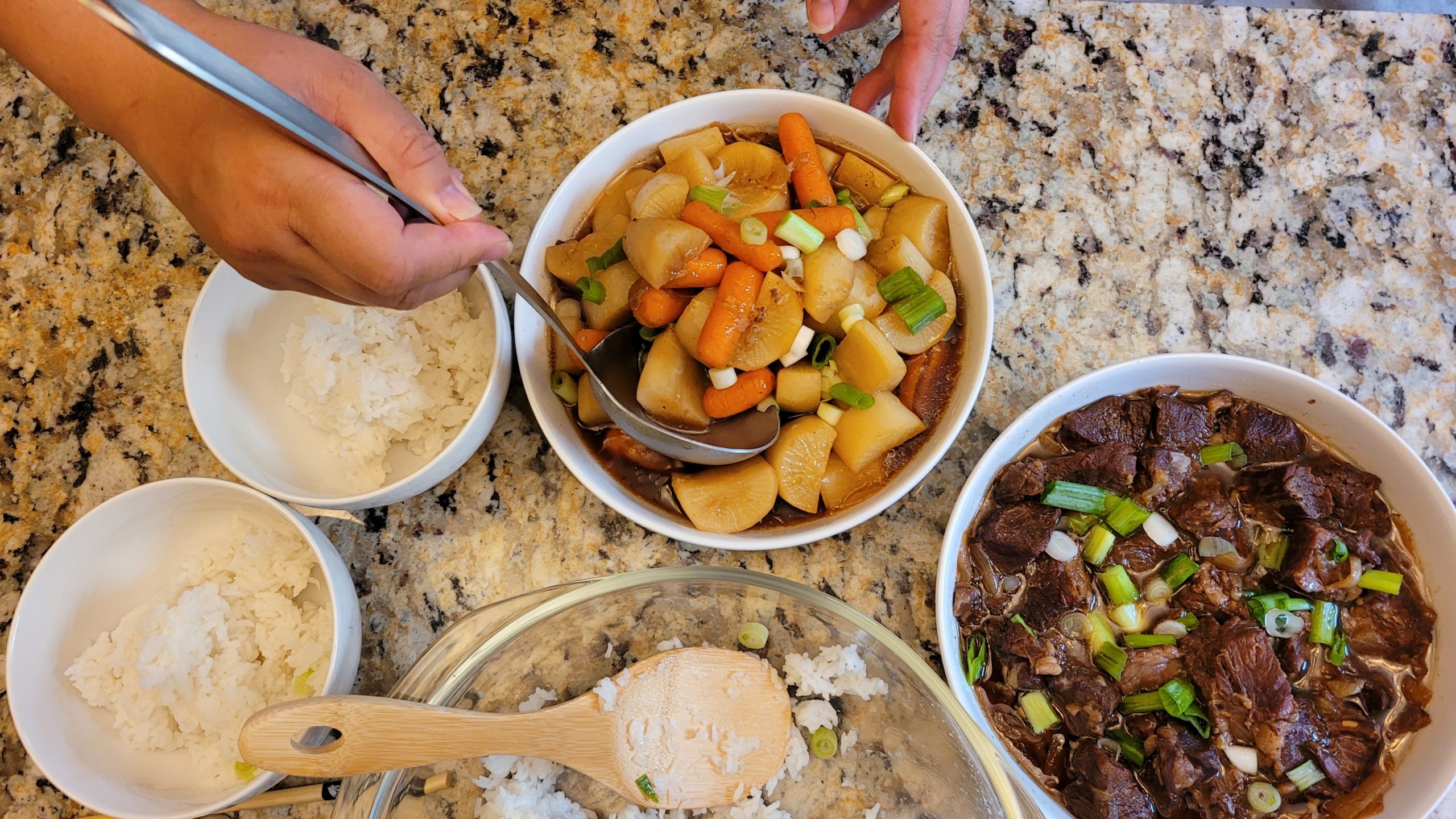Hello, Cincinnati! – Hyde Park Neighborhood and Architectural Tour & Real Estate Info


You can see many of the City of Cincinnati’s signs around the city in the same style as this Hyde Park Square sign.
Hyde Park, A Village-like Neighborhood Nestled in the City of Cincinnati
In a nutshell, Hyde Park is a beautiful place to live. Luckily, I call this neighborhood in Cincinnati, Ohio, my home. Also, Hyde Park is my workplace, where I am an agent at the Sibcy Cline Realtors® at the Hyde Park office. The community lies on the 71 north/south corridor on the east side of the city. Some of the jewels of the district include Hyde Park Square, Ault Park, and Street Gas Lamps. Inherently, its picturesque corridors and architecture make Hyde Park a special neighborhood.

This is a map of Hyde Park outlined in red taken from Google Maps, 9/8/22.
Are you interested in learning more?
In late August 2022, I created a YouTube video that showcases the appeal of the Hyde Park Neighborhood. In summary of the video, I highlight its business district and residential feel, the history of Hyde Park, the MLS data (newer data is listed in the article), and Niche.com overview.
Business District Attractions & Residential Achitectural Style
All in all, Hyde Park has a lovely, traditional, village-like feeling as you walk down the business district surrounding Hyde Park Square. One can see Italianate, art deco, and contemporary, among other architectural styles in the buzzing quaint retail center. Similarly, the residential areas match this aesthetic and sentiment. Along the avenues and streets, homes carry a traditional vibe with occasional contemporary abodes. Inside the neighborhood, visitors and residents can point out the many homes from the turn of the 19th Century to the early 20th century. Frequently, you can spot American Four Squares, Victorians, Tudors, Colonial Revivals, Mission Revivals, Shingled, and Art Deco multi-plexes. Occasionally, you might find some contemporaries scattered throughout and occasional storybook homes amongst other styles. Overall, the feeling is of intentional beauty.
History
Looking back at Hyde Park, named after the famously affluent Hyde Park of New York, it was transformed from a rural area to a desirable community. Its rise to popularity grew when a train connection to Cincinnati’s downtown made the area more accessible. If you are curious more about the history of Hyde Park in the video, visit Sibcy Cline Community Guide, Haus & Home Magazine, Wikipedia. There you can learn about the Mornington syndicate, a group of wealthy businessmen, who developed the area, and other information.

Grand second empire-styled house in Hyde Park, Cincinnati.
MLS Data
Moving forward, we have numbers. Drawing from the summer data in the CincyMLS, the Multiple Listing Service is a resource used by real estate brokers and realtors, the Hyde Park market is competitive for buyers and lucrative for sellers. One week into September, there are 34 properties on the market. From June 1 to August 31, 2022, 92 properties were sold. Furthermore, the median summer price was $450,000. Where, as of September 8, the current active median price of homes is $531,900. Checking out this graphic, you can see that the market is still lucrative and strong in Hyde Park.

This graphic shows the currently active (as of Sept 8, 2022) and Summer 2022 sold data for Hyde Park.
Last Remarks
In closing, I hope that curious readers developed a sense of what it feels like to live in Hyde Park. Please watch the video I made for fantastic visuals of the neighborhood. If you haven’t already, visit Hyde Park Square and the residential areas. While you are here, feel free to drop by the office to say hello to me! I’m here for all of your real estate needs in Cincinnati and beyond! I’m local & I’m global.
Hello, Cincinnati! The Pursuing of Happiness

Hello, Cincinnati! I am Monica Nash (née Lee) a real estate agent in Cincinnati, OH, at Sibcy Cline Realtors®. Formerly, I was a teacher in San Francisco, California, my hometown. I also lived in Austin, TX, for 7 years as a teacher and Realtor®. This article is a snippet of the story of why I moved to Cincinnati from San Francisco. As part of the mass exodus of Californians, I left my hometown in hopes to find a better life, experiencing a different culture, and re-entering the real estate profession. For the full article, visit medium.com.
The Great Escape
Teaching during the pandemic was overwhelming, to say the least, and the restrictions in San Francisco were pretty stringent. On weekends and evenings, my escape was YouTube. My husband Ben and I started looking for places to escape to. Yes. I would call it to escape because it was like looking for a vacation. When I wasn’t preparing a lesson, grading papers, writing recommendations, doing report cards, emailing a parent, eating, or sleeping; we would escape to YouTube to watch realtors talk about their hometowns, and why we should Buy! Buy! Buy! We were hooked.
At first, we were looking to relocate to Southern California, Raleigh, Charlotte, Tampa, and even Boise, and Chattanooga, TN. Then, there was Cincinnati, OH. On our part, we fell in love with the city, and quite by accident. Ben was looking for a location in rural Ohio that he recognized from another video unrelated to real estate. Then the funniest thing happened because of the YouTube algorithm. YouTube was on auto-play–and seemingly serendipitous– presented to us a video about Cincinnati, OH. So technically speaking, so to speak, YouTube found our next hometown.
Hello, Cincinnati!
Though hazy with time, my first introduction to Cincinnati was on the 70’s reruns of “WKRP in Cinncinati” with Loni Anderson. Later, about 10 years ago, we had driven through Cincinnati on the way to Greenville, OH, to visit my mother-in-law for Thanksgiving. We were so enchanted by the John A. Roebling Suspension Bridge, the city’s architecture, and the liveliness of its people, that it was imprinted in our minds.

Hello, Cincinnati! on Facebook. Sibcy Cline Realtors® is my brokerage. Pictured above is the famous John A. Roebling Suspension Bridge. Roebling also designed and built the Brooklyn Bridge.
Fast forward, we searched more about Cincinnati, Cincy, the Queen City, Ohio, why to move to Ohio, not to move to OHIO, and then there was real estate. We became obsessed with a YouTube channel by local Cincinnati realtor influencer, Eric Stzanyo. We watched hours upon hours of videos about Cincinnati. Ben applied for a job at a forward-moving web development company in Cincinnati, and the rest is history. He got the job, and we moved.
Since moving to Cincinnati, with an extraordinary 2-month pit stop with my inlaws’ in Greenville, I have quite possibly never been happier. There is a welcomed spark in life unknown to me for a while.

My mother-in-law, Rebecca Penkwitz; Ben, and me at MadTree Brewing in Cincinnati, OH.
One might ask, what makes Cincinnati so special? There is a vibrant soul to Cincinnati that many American cities lack, especially the younger ones. There is diversity, not just by race, but also by culture and socioeconomics. There is a chance for upward mobility, not just for the technology-inclined bourgeoisie. Even with limited inventory, there is comparatively affordable real estate. You can still buy a home for your family for under $300,000 in a decent neighborhood, and enjoy the life of a bonafide mid-sized city.
Also, Cincinnati is in the Mid-West. There is something about Ohio that I have known from decades ago when I met my first Ohioans in my Study Abroad program. People from Ohio are stereotypically honest, genuine, kind, giving, sorted, and down-to-earth. Those are some good stereotypes. In my experience, some folks might enjoy a penchant for gossip, but hey, who doesn’t like a good scoop?
In closing, in the pursuit of my happiness, I found Cincinnati. It has been a journey, but I like it. However, I know Cincinnati is not for everyone. It has its faults, of course. So here’s the pitch. There is a big world out there. Explore it while you are young, middle-aged, and retired. It’s never too late.
My advice is: don’t feel like you have to be stuck in the same place forever. There is somewhere else that may be calling you. You just may not know it. Don’t forget the cliche, because it is true, “the world is your oyster.” Cincinnati just happens to be mine.
How to Make Cantonese Food in Cincinnati

I adore Cincinnati, and I love that it is a town for foodies. When I relocated to Cincinnati with my husband, I knew that Cantonese food might be harder to come by. As a blessing in disguise, I now explore Cincinnati’s culinary options with its plethora of markets where Asian food lovers buy hard-to-find ingredients. The options for food markets are tremendous.
I hope you join me on my culinary adventures, try some new foods, reach out to me when you try this recipe for beef and daikon stew, and tell me how it tasted.

Pictured here, is Cantonese-Inspired Beef & daikon Stew being served up in an American Kitchen using an Instant Pot instead of a clay pot. See the recipe at the end of the article.
My History with Beef & Daikon Stew
I love traditional Cantonese-Chinese foods. It’s my heritage: my father’s family is Cantonese. When my father was five, he moved to San Francisco, California, from Taishan, China, a Cantonese region. Many of the Chinese people in San Francisco migrated from this region. As a first-generation Chinese-American, I grew up in San Francisco being part of the most common minority there. If you are curious, you can get a general rundown about who Cantonese people are from Wikipedia: “Guangzhou (historically known as Canton) and its surrounding area in Southeastern China,” and the Hong Kong area. In addition, Chung Ying’s blog is a great resource about Cantonese foods.

In this picture, show is the Lee Family (minus my sister) after enjoying our clay pot dishes at a Cantonese-Chinese Restaurant in San Francisco.
Finding good Cantonese Chinese food and restaurants in San Francisco is easy. Beef and daikon stew was a favorite dish of mine for my family to order at restaurants. The dish is hearty, earthy, and delicious over rice or egg noodles.

Beef & daikon stew over jasmine rice garnished with green onions and served with chopsticks in a white ceramic bowl.
Pre-COVID, I had never cooked too many Chinese dishes on my own. A silver lining to the pandemic was learning how to cook better. During the pandemic, I moved back to San Francisco to be closer to my grandmother, the matriarch of the Lee family, who owns the family’s multi-generational home. Part of the reason my husband and I moved into one of the units was to keep her company during what would have been a very lonely time for her. It was there that I learned to cook for my grandmother’s tastes while we were bunkered up with no restaurants to enjoy. Beef and daikon stew was one of our favorites for me to make on our weekly, big, Sunday dinners.
Shopping for Hard-to-Find at Cincinnati’s Jungle Jim’s International Market: A Foodie’s Paradise
Jungle Jim’s is my “go-to” for Asian Foods. If you haven’t already fallen in love with Jungle Jim’s, it’s a must-see on your Cincinnati list of places to go.

This picture shows a snapshot of the seafood and meat market at Jungle Jim’s. Jungle Jim’s is an international market in the Cincinnati Area with two locations: Fairfield and Eastgate.
I adore Jungle Jim’s because it is a one-stop shop for African, Middle Eastern, Eastern European, European, Hispanic, Indian, Asian, to American international foods. According to Jungle Jim’s, there are “200,000 square feet of shopping space in each of our stores, there are over 180,000 products from which to choose.” I enjoy shopping there for its robust Asian food section. The international market boasts several aisles dedicated to Asian foods organized into 10 countries, including — China, Japan, Thailand, Indonesia, Korea, Philippines, Taiwan, Hong Kong, Vietnam, and Malaysia.
On my last visit, I looked for ingredients for my Cantonese-inspired beef & daikon stew recipe. You can purchase all the ingredients needed for the stew at Jungle Jims. In the recipe, I included ingredients that you can substitute with the items listed in the recipe. These substitutions can all be bought at Kroger or other Western/American stores. (Actually, when I was at Jungle Jim’s, I forgot to buy the daikon. I went to our local Kroger in Hyde Park, to pick up it where they carry organic daikon.)
This is a video that I took of my visit to Jungle Jim’s, specifically the Asian aisle. Watch my trip to Jungle Jim’s on YouTube on my segment, Hello, Cincinnati!
Some of the differences between traditional Beef and Daikon Stew are that I used a pressure cooker instead of a clay pot; I used 5-Spice powder (cinnamon, cloves, fennel, star anise, and Sichuan peppercorns) instead of using the traditional whole cloves, star anise, and Sichuan peppercorns pieces; and substituted the beef rough flank for chuck roast. However, rough flank or drop flank — not to be confused with flank steak — is a tough, cut of meat that has tendon, sinews, gristly bits, and gelatinous pieces when slow cooked; it is difficult to find outside of Chinese/Asian markets. The instructions in the following recipe instruct to separate the cooking of the beef and the daikon, though I have also cooked the vegetables in a different order as seen in this Tiktok video that I made.
RECIPE: Instant Pot Beef & Daikon Stew

Close-up of beef & daikon stew served in two medium-sized bowls
Ready in about 2 Hours
Serves 8 people
Appliances Instant Pot or Pressure Cooker
Ingredients
- 2lbs beef chuck roast
- 1.5 in of ginger or three slices
- 6 cloves of garlic crushed
- 1 medium onion roughly chopped
- ½ Tbsp of white pepper
- 1 Tbsp of sugar
- 2 Tbsp of 5-spice powder
- 1 Tbsp of dark soy sauce
- 1 Tbsp of hoisin sauce
- 1 Tbsp of soy sauce
- 2 Tbsp of oyster sauce
- 2 Tbsp of rice wine (i.e. Mirin or Shaoxing Wine)
- 3 bay leaves
- Water
- 1 medium to large daikon
- ½ lb of baby carrots
- 2 green onion stalks
- Serve with Jasmine white rice or your choice of Hong Kong noodles
Preparation
- Cut the beef chuck roast into stew-sized pieces. Roughly, the length of each side might be 1.5 inches to 2 inches depending on preference. Add beef to Instant Pot.
- Add ginger, garlic, onion, white pepper, sugar, 5-spice powder, dark soy sauce, hoisin sauce, soy sauce, oyster sauce, rice wine, and bay leaves to Instant Pot. Mix until sauce evenly coats the mixture.
- Pour water over the mixture until covering the ingredients.
- Place lid over Instant Pot. Set pressure on high for 30 minutes. It will take several minutes to come to pressure before the countdown starts.
- While beef is cooking, wash, peel, and cut Daikon in half length-wise and then cut into ¾-inch slices while the meat is pressure cooked.
- When the timer goes off, naturally vent for 15 minutes. This will help the meat continue slow cooking and become tender. Release the rest of the pressure and remove the lid.
- Remove beef and large solid pieces from Instant Pot leaving most of the broth in the pot. It’s okay if you leave some pieces behind.
- Add daikon and carrots to the broth.
- Place lid over Instant Pot. Set pressure on high for 12 minutes. Allow the pressure cooker to come to pressure before the countdown starts. Release pressure manually when the timer goes off.
- Remove vegetables. You can either add the vegetables to the beef or keep them separate in another bowl.
- Serve over rice or noodles.
- Garnish with chopped green onions.
Pro Tip
If you are a daikon fan and want to cook the vegetables with the meat for part of the time to infuse the flavors more, follow steps 1–5.
Then, when instead of naturally venting for 15min, release pressure manually. Add daikon and carrots to stew. Pressure cook for 10 minutes. Vent naturally for 5–10 minutes and then release the remaining pressure manually. See my TikTok video as a guide.
Substitutions
- Chuck roast: Brisket or rough flank (not to be confused with flank steak)
- White pepper: Black pepper
- 5-Spice powder: Chinese cinnamon, fennel seed, star anise, and cloves instead of
- Dark Soy Sauce: Soy sauce, teriyaki sauce, more oyster sauce, more hoisin sauce, double black soy sauce, Worcestershire sauce, mushroom-flavored dark soy
- Hoisin: Bean paste, garlic teriyaki, garlic and prunes, chili and plums, barbecue molasses, soy peanut butter, miso and mustard, ginger plum
- Oyster sauce: Fish sauce, hoisin sauce, Worcestershire sauce with soy sauce, teriyaki sauce, vegan mushroom sauce
- Rice wine: Pale dry sherry, gin & wine, Japanese rice wines, Mirin, Shaoxing
- Daikon: White turnips, radishes, parsnips, jicama, cabbage hearts
- Jasmine white rice: long grain white rice or long grain brown rice
- Hong Kong noodles: your choice of noodles
Feel free to print or share this recipe from Google Docs.
This is an instructional video that I made of how beef and daikon stew is made in an Instant Pot. Watch this step-by-step recipe on my TikTok channel, @hello.cincinnati.
For more cooking videos from Ms. Monica Cooks, “Super Tasty Foods from All Over,” you can check out my Instagram @hello.cincinnati & TikTok @hello.cincinnati search hashtag #msmonicacooks; or visit my YouTube channel, Ms. Monica Cooks. For more exploration of Cincinnati, search for the #hellocincinnati.

 Facebook
Facebook
 X
X
 Pinterest
Pinterest
 Copy Link
Copy Link


